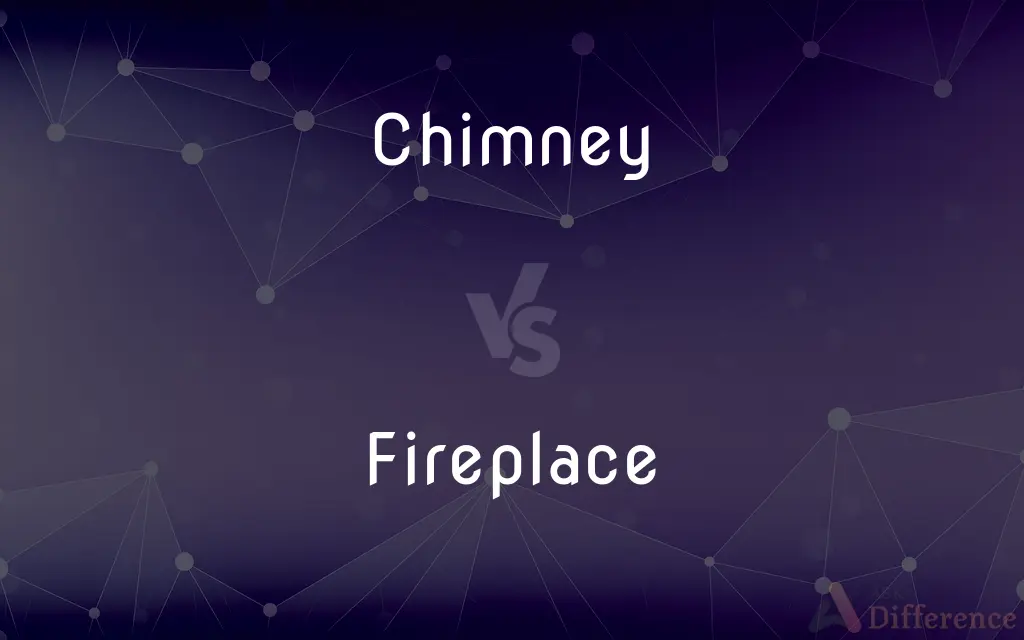Chimney vs. Fireplace — What's the Difference?
Edited by Tayyaba Rehman — By Maham Liaqat — Updated on March 5, 2024
A chimney is a structure providing ventilation for smoke from a fireplace or furnace. A fireplace is an architectural feature in a home where fires are made, offering warmth and ambiance.

Difference Between Chimney and Fireplace
Table of Contents
ADVERTISEMENT
Key Differences
A chimney serves as a vertical channel or passage designed to direct smoke and combustion gases away from an indoor space to the outside atmosphere. Its primary function is to ensure safety and comfort by removing potentially harmful byproducts of combustion from living areas. On the other hand, a fireplace is a specific architectural element within a building that houses a fire, typically used for heating the space or for aesthetic purposes. It is an open or enclosed area where wood, gas, or other fuels can be burned to generate heat.
While the chimney is a critical component of the fireplace system, facilitating the safe expulsion of smoke and gases, the fireplace itself is the focal point where the actual fire is contained and managed. This distinction underscores the complementary roles of both elements in providing warmth and atmosphere, with the chimney acting as a support system to the fireplace's central function.
Chimneys are constructed using materials like brick, stone, or metal and extend above the roofline to ensure that smoke is released at a height that prevents re-entry into the building or causing a nuisance to occupants and neighbors. Fireplaces, conversely, are built into the lower part of a room and can vary significantly in design, from traditional masonry hearths to modern gas or electric units, reflecting both functional and decorative considerations.
Maintenance and cleaning are crucial for both chimneys and fireplaces; however, they address different concerns. Chimney cleaning focuses on removing soot, creosote, and blockages to prevent chimney fires and improve efficiency, while fireplace maintenance involves cleaning the firebox, grates, and ensuring the fire is managed safely.
Chimneys require careful planning to ensure structural integrity and effective ventilation, often impacting the building's design and layout. Fireplaces, while also subject to design considerations, offer more flexibility in terms of aesthetic choices and can be added or modified with fewer structural constraints than chimneys.
ADVERTISEMENT
Comparison Chart
Definition
A structure for ventilating smoke.
An architectural feature for making fires.
Primary Function
Ventilation of combustion gases.
Generation of heat and ambiance.
Location
Extends vertically above the building.
Built into a room.
Construction Materials
Brick, stone, metal.
Brick, stone, metal, or other materials.
Maintenance
Cleaning of soot and blockages.
Cleaning of firebox and safe fire management.
Architectural Impact
Integral to building design for safety.
Flexible in design, adds aesthetic value.
Safety Concerns
Prevents smoke re-entry and chimney fires.
Ensures containment and safe management of fire.
Compare with Definitions
Chimney
Requires regular maintenance for efficiency.
They scheduled a chimney cleaning service annually.
Fireplace
An area in a room for making fires.
The living room had a cozy fireplace.
Chimney
An essential part of the building's heating system.
Smoke was billowing from the chimney.
Fireplace
Offers warmth and aesthetic appeal.
They gathered around the fireplace during the cold evening.
Chimney
A vertical structure for smoke ventilation.
The house had a tall brick chimney.
Fireplace
Can use various fuels like wood or gas.
Their fireplace could be operated with natural gas.
Chimney
Extends above the roof for effective smoke release.
The new design included a chimney for the wood stove.
Fireplace
Integral to home heating and ambiance.
The stone fireplace was the focal point of the room.
Chimney
Designed to ensure safety and comfort.
The chimney needs to be swept before winter.
Fireplace
Needs regular cleaning and safe fire management.
After every use, they cleaned the fireplace to remove ash.
Chimney
A chimney is an architectural ventilation structure made of masonry, clay or metal that isolates hot toxic exhaust gases or smoke produced by a boiler, stove, furnace, incinerator or fireplace from human living areas. Chimneys are typically vertical, or as near as possible to vertical, to ensure that the gases flow smoothly, drawing air into the combustion in what is known as the stack, or chimney effect.
Fireplace
A fireplace or hearth is a structure made of brick, stone or metal designed to contain a fire. Fireplaces are used for the relaxing ambiance they create and for heating a room.
Chimney
A passage through which smoke and gases escape from a fire or furnace; a flue.
Fireplace
An open recess for holding a fire at the base of a chimney.
Chimney
The usually vertical structure containing a chimney.
Fireplace
A structure, usually of stone or brick, for holding an outdoor fire.
Chimney
A fireplace or hearth.
Fireplace
An open hearth for holding a fire at the base of a chimney.
Chimney
A tube usually of glass, placed around a flame, as of a lamp, to create a draft, and promote combustion.
Fireplace
The part a chimney appropriated to the fire; a hearth; - usually an open recess in a wall, in which a fire may be built.
Chimney
A vertical flue that provides a path through which smoke from a fire is carried away through the wall or roof of a building
Chimney
A glass flue surrounding the wick of an oil lamp
Common Curiosities
Why are chimneys taller than the roofline?
Chimneys are taller than the roofline to ensure smoke is released at a height that prevents re-entry and disperses effectively.
Can a fireplace exist without a chimney?
Yes, some modern fireplaces, especially electric or ventless gas models, can exist without a traditional chimney.
What maintenance does a chimney require?
Chimney maintenance involves cleaning soot, creosote, and removing blockages to prevent fires and ensure efficient operation.
How do fireplaces contribute to heating?
Fireplaces contribute to heating by burning fuel to generate warmth directly into the living space.
What materials are used to build chimneys and fireplaces?
Both chimneys and fireplaces are commonly constructed from materials like brick, stone, or metal, chosen for durability and heat resistance.
What is the primary function of a chimney?
The primary function of a chimney is to ventilate smoke and combustion gases from a fireplace or furnace to the outside.
How does a fireplace enhance a home?
A fireplace enhances a home by providing warmth, ambiance, and aesthetic appeal.
Can fireplaces be used with different types of fuel?
Yes, fireplaces can be designed to use various types of fuel, including wood, gas, and electricity.
Is a chimney cleaning necessary every year?
Yes, annual chimney cleaning is recommended to prevent chimney fires and maintain efficiency.
What are the benefits of a gas fireplace over a wood-burning one?
Gas fireplaces offer benefits like easier operation, less maintenance, no need for wood storage, and often, the elimination of the need for a traditional chimney.
How do ventless fireplaces work without a chimney?
Ventless fireplaces burn fuel very efficiently, producing minimal combustion gases that can be safely released into the room without the need for a chimney.
How can the efficiency of a fireplace be maximized?
The efficiency of a fireplace can be maximized by using the right fuel, ensuring proper ventilation, and regular maintenance.
What safety concerns are associated with chimneys and fireplaces?
Key safety concerns include preventing chimney fires through regular cleaning and ensuring fireplaces are used and managed safely to avoid accidents.
What role does a chimney play in home design?
The chimney plays a critical role in home design by impacting the building's layout and ventilation system while adding architectural interest.
What factors should be considered when installing a fireplace?
Factors to consider include the type of fireplace, fuel source, ventilation requirements, safety regulations, and the desired aesthetic appeal.
Share Your Discovery

Previous Comparison
Delicate vs. Fragile
Next Comparison
Stand vs. SteadyAuthor Spotlight
Written by
Maham LiaqatEdited by
Tayyaba RehmanTayyaba Rehman is a distinguished writer, currently serving as a primary contributor to askdifference.com. As a researcher in semantics and etymology, Tayyaba's passion for the complexity of languages and their distinctions has found a perfect home on the platform. Tayyaba delves into the intricacies of language, distinguishing between commonly confused words and phrases, thereby providing clarity for readers worldwide.














































